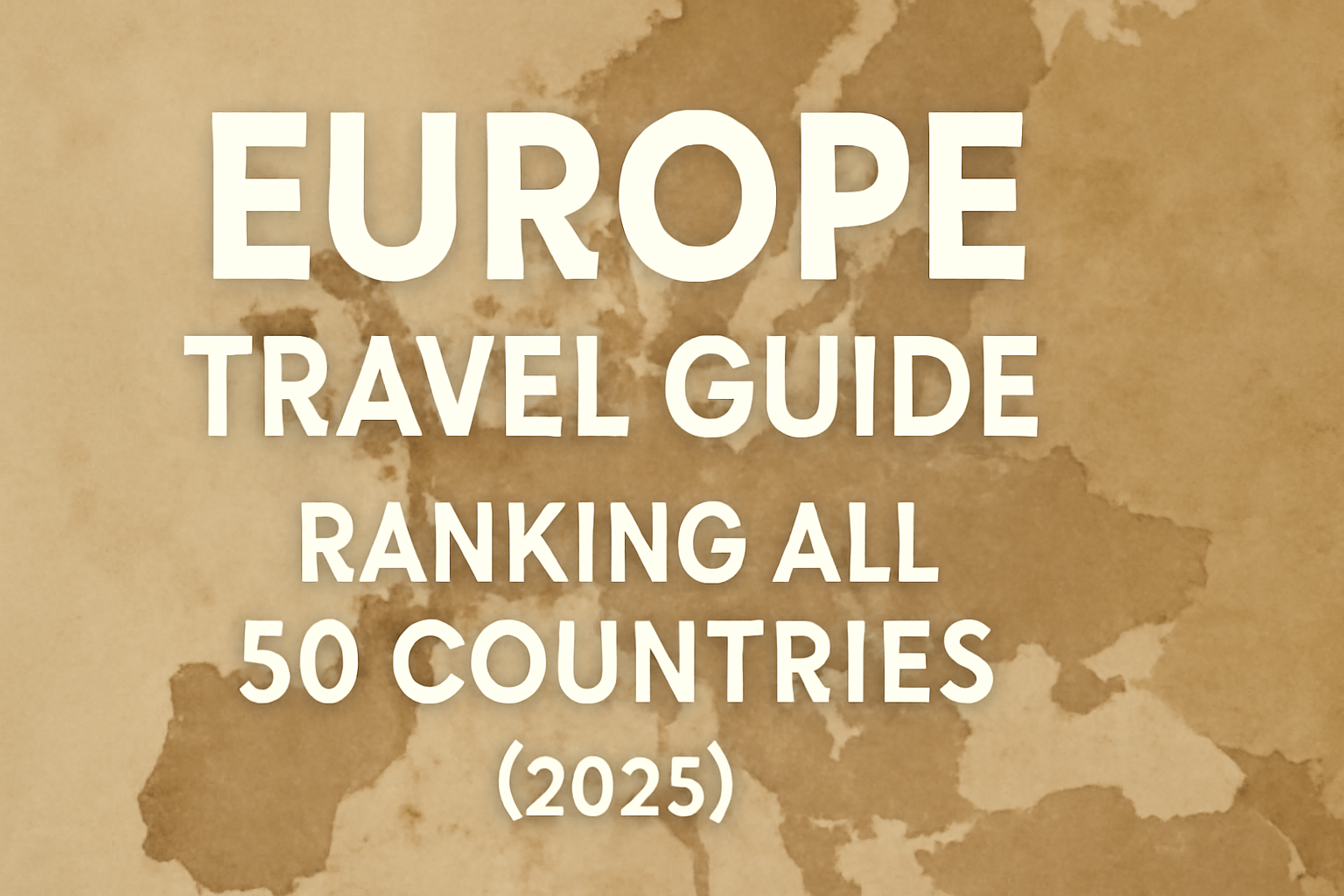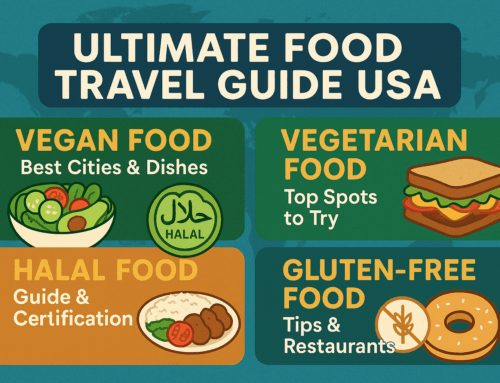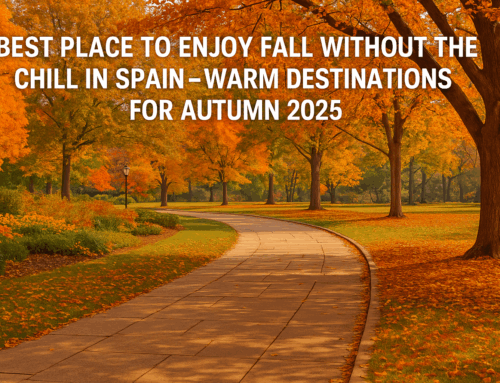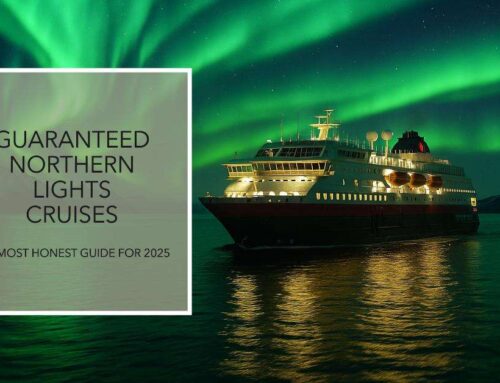Europe Travel Guide: Ranking the 50 Countries
Contents
- 1 Europe Travel Guide: Ranking the 50 Countries
- 2 Europe’s 50 Top Destinations: A Traveler’s Paradise
- 2.1 Prague, Czech Republic: Top Choice
- 2.2 Belgrade, Serbia: Number Two
- 2.3 Barcelona, Spain: Number Three
- 2.4 Reykjavik, Iceland: Number Four
- 2.5 Kyiv, Ukraine: Number Five
- 2.6 Lisbon, Portugal: Number Six
- 2.7 Bucharest, Romania: Number Seven
- 2.8 Amsterdam, Netherlands: Number Eight
- 2.9 Vienna, Austria: Number Nine
- 2.10 Rome, Italy: Number Ten
- 2.11 Ljubljana, Slovenia: Number Eleven
- 2.12 Zurich, Switzerland: Number Twelve
- 2.13 Oslo, Norway: Number Thirteen
- 2.14 Istanbul, Turkey: Number Fourteen
- 2.15 Germany: Number Fifteen
- 2.16 Tbilisi, Georgia: Number Sixteen
- 2.17 Stockholm, Sweden: Number Seventeen
- 2.18 Dublin, Ireland: Number Eighteen
- 2.19 Moscow, Russia: Number Nineteen
- 2.20 Dubrovnik, Croatia: Number Twenty
- 2.21 Warsaw, Poland: Number Twenty-One
- 2.22 London, United Kingdom: Number Twenty-Two
- 2.23 Budapest, Hungary: Number Twenty-Three
- 2.24 Athens, Greece: Number Twenty-Four
- 2.25 Sofia, Bulgaria: Number Twenty-Five
- 2.26 Copenhagen, Denmark: Number Twenty-Six
- 2.27 Bratislava, Slovakia: Number Twenty-Seven
- 2.28 Tallinn, Estonia: Number Twenty-Eight
- 2.29 Riga, Latvia: Number Twenty-Nine
- 2.30 Vilnius, Lithuania: Number Thirty
- 2.31 Brussels, Belgium: Number Thirty-One
- 2.32 Podgorica, Montenegro: Number Thirty-Two
- 2.33 Sarajevo, Bosnia: Number Thirty-Three
- 2.34 Tirana, Albania: Number Thirty-Four
- 2.35 Skopje, North Macedonia: Number Thirty-Five
- 2.36 Nicosia, Cyprus: Number Thirty-Six
- 2.37 Valletta, Malta: Number Thirty-Seven
- 2.38 Pristina, Kosovo: Number Thirty-Eight
- 2.39 Chisinau, Moldova: Number Thirty-Nine
- 2.40 Minsk, Belarus: Number Forty
- 2.41 Paris, France: Number Forty-One
- 2.42 Yerevan, Armenia: Number Forty-Two
- 2.43 Helsinki, Finland: Number Forty-Three
- 2.44 Vaduz, Liechtenstein: Number Forty-Four
- 2.45 San Marino, San Marino: Number Forty-Five
- 2.46 Baku, Azerbaijan: Number Forty-Six
- 2.47 Monaco, Monaco: Number Forty-Seven
- 2.48 Andorra la Vella, Andorra: Number Forty-Eight
- 2.49 Luxembourg, Luxembourg: Number Forty-Nine
- 2.50 Vatican City, Vatican City: Number Fifty
- 2.51 FAQs
At Desmo Travel, we explored all 50 European countries. Here is our clear and simple ranking of Europe’s best cities, highlighting what makes each special.
Ranking Criteria
We chose cities based on:
- Local friendliness
- Budget-friendly travel
- Quality of food
- Nightlife
- Scenic beauty
- Historical sites
- Authentic local experiences
Top 10 Countries
-
Czech Republic: Prague’s medieval architecture, affordable prices, and charming towns make it my favorite European destination.
-
Serbia: Belgrade’s energy, friendly locals, and rich history offer an authentic Balkan experience.
-
Spain: From Barcelona to Andalusia, Spain delivers vibrant culture, stunning architecture, and incredible food.
-
Iceland: A paradise for nature lovers with breathtaking landscapes, geothermal spas, and the chance to see the Northern Lights.
-
Ukraine: Despite recent challenges, Ukraine’s affordability, beautiful cities like Kyiv and Lviv, and resilient people make it a special destination.
-
Portugal: From Lisbon to the Algarve coast, Portugal offers affordability, warm hospitality, and beautiful landscapes.
-
Romania: Explore Transylvania, Brasov, and Bucharest for a mix of history, folklore, and emerging tech scene.
-
Netherlands: Amsterdam’s canals, open-minded culture, and excellent food make it a highlight of Western Europe.
-
Austria: A blend of classical music heritage, Alps beauty, and charming cities like Salzburg and Vienna.
-
Italy: Home to art, history, and cuisine, with highlights including Florence, Rome, and the lakes region.
Middle Rankings
-
Slovenia: Lake Bled and charming Ljubljana offer natural beauty and a relaxed atmosphere.
-
Switzerland: Stunning Alps, clean cities, and outdoor activities justify its high prices.
-
Norway: Fjords, midnight sun, and outdoor adventures make it a Scandinavian gem.
-
Turkey: A crossroads of cultures with historical sites, delicious food, and friendly people.
-
Germany: Mix of history, culture, and modern cities like Berlin and Munich.
-
Georgia: A blend of European and Asian influences with excellent wine and friendly locals.
-
Sweden: Clean cities, outdoor activities, and Swedish meatballs make it a Scandinavian delight.
-
Ireland: Cliffs of Moher, friendly locals, and vibrant cities like Dublin offer a true Irish experience.
-
Russia: Despite political challenges, Russia offers rich culture, beautiful cities, and unique experiences.
-
Croatia: Medieval towns like Dubrovnik, beautiful coastlines, and islands make it a Balkan standout.
Lower Rankings
-
Poland: Affordable prices, hearty food, and historic cities like Krakow.
-
United Kingdom: A mix of history, culture, and modern cities like London.
-
Hungary: Budapest’s thermal baths, ruin pubs, and Lake Balaton offer unique experiences.
-
Greece: Islands like Santorini and Crete provide beautiful landscapes and history.
-
Bulgaria: Affordable prices, Black Sea beaches, and rich history.
-
Denmark: Clean cities, excellent food, and Copenhagen’s charm.
-
Slovakia: Affordable prices, beautiful mountains, and charming Bratislava.
-
Estonia: Medieval Tallinn, tech-savvy culture, and beautiful Baltic coastline.
-
Latvia: Riga’s architecture, outdoor activities, and Baltic charm.
-
Lithuania: Vilnius’s old town, Jewish history, and Baltic beauty.
-
Belgium: Home to Brussels, Belgian waffles, and the incredible Tomorrowland festival.
-
Montenegro: Coastal beauty, ancient towns, and excellent seafood.
-
Bosnia: Sarajevo’s history, Mostar’s bridge, and affordable prices.
-
Albania: Mix of Italian and Turkish influences with beautiful mountains and beaches.
-
North Macedonia: Lake Ohrid, Skopje’s statues, and Balkan vibes.
-
Cyprus: Split between Greek and Turkish influences, offering beaches and history.
-
Malta: Mediterranean charm, World War II history, and excellent beaches.
-
Kosovo: Pristina’s cobblestone streets, friendly locals, and Balkan culture.
-
Moldova: Affordable prices, excellent wine, and a mix of Russian and Ukrainian influences.
-
Belarus: Minsk’s charm, affordability, and Soviet-era architecture.
-
France: Despite some challenges, France offers incredible history, culture, and natural beauty.
-
Armenia: Mountain resorts, friendly locals, and a rich cultural heritage.
-
Finland: Lapland’s reindeer, Arctic Circle, and northern lights.
-
Liechtenstein: A relaxing, quaint country with beautiful views.
-
San Marino: A tiny country within Italy with limited attractions.
-
Azerbaijan: A mix of Middle Eastern and Silk Road influences with friendly locals.
-
Monaco: A playground for the rich with expensive accommodations and limited attractions.
-
Andorra: A nature lover’s paradise with skiing and hiking opportunities.
-
Luxembourg: A small country with limited cultural attractions for travelers.
-
Vatican City: The smallest country in the world with incredible religious history.
Why Trust This Guide?
Desmo Travel experts and Customers who have visited all 50 European countries multiple times. We rank destinations using strict criteria: local friendliness, budget value, food quality, nightlife, scenery, historical depth, and authentic cultural experiences. This guide combines 2025 best practices with human expertise for reliable, actionable advice.
Let Desmo Travel’s free itinerary planner craft the ideal trip—customized in real-time based on your budget, weather, and local events.
👉 Start Planning Now
Europe’s 50 Top Destinations: A Traveler’s Paradise
Prague, Czech Republic: Top Choice
Why Prague Stands Out
-
Scenic Charm: Prague offers beautiful parks, cozy cafes, and lively bars.
-
Affordable Prices: Costs are lower than in Western Europe. For example, beer is around $2, while bottled water may cost $3.
-
Safety and Cleanliness: Prague provides a clean and safe environment for travelers.
-
Cultural Fusion: Located between East and West Europe, Prague delivers diverse cultural experiences.
Hidden Gem: Cesky Krumlov
Customer Review
Belgrade, Serbia: Number Two
Why Belgrade Stands Out
-
Affordability: Budget-friendly destination with excellent value for money.
-
Rich History: Explore ancient castles and historical sites.
-
Cultural Vibes: Experience the energetic and friendly Serbian atmosphere.
-
Culinary Delights: Try local specialties like cevapi and drink traditional yogurt-based beverages.
Hidden Gem: Novi Sad
Customer Review
Barcelona, Spain: Number Three
Why Barcelona Stands Out
-
Architectural Wonders: Explore Gaudi’s famous works like Sagrada Familia.
-
Beaches and Sun: Enjoy beautiful Mediterranean beaches.
-
Culinary Delights: Savor tapas, paella, and fresh seafood.
-
Nightlife: Experience lively bars and clubs.
Hidden Gem: Granada
Customer Review
Reykjavik, Iceland: Number Four
Why Reykjavik Stands Out
-
Natural Beauty: Accessible to geysers, hot springs, and waterfalls.
-
Midnight Sun: Experience 24/7 daylight in summer.
-
Whale Watching: Opportunities to see whales in their natural habitat.
-
Northern Lights: Great chance to witness this spectacular phenomenon.
Hidden Gem: Vik
Customer Review
Kyiv, Ukraine: Number Five
Why Kyiv Stands Out
-
Affordable Prices: Budget-friendly destination with excellent value.
-
Rich History: Explore ancient churches and historical sites.
-
Cultural Experiences: Enjoy traditional Ukrainian dance and music.
-
Culinary Delights: Try borscht and other Ukrainian specialties.
Hidden Gem: Lviv
Customer Review
Lisbon, Portugal: Number Six
Why Lisbon Stands Out
-
Hills and Views: Enjoy beautiful viewpoints across the city.
-
Culinary Delights: Taste pastéis de nata and fresh seafood.
-
Beaches: Accessible to beautiful coastal areas.
-
History: Explore ancient castles and historical sites.
Hidden Gem: Porto
Customer Review
Bucharest, Romania: Number Seven
Why Bucharest Stands Out
-
Affordable Prices: Budget-friendly destination with excellent value.
-
Rich History: Explore ancient churches and historical sites.
-
Cultural Experiences: Enjoy traditional Romanian music and dance.
-
Culinary Delights: Try sarmale and other Romanian specialties.
Hidden Gem: Brasov
Customer Review
Amsterdam, Netherlands: Number Eight
Why Amsterdam Stands Out
-
Canals and Bikes: Explore the city on a bike.
-
Museums: Visit world-famous museums like the Rijksmuseum.
-
Culinary Delights: Taste Dutch pancakes and other specialties.
-
History: Explore ancient buildings and historical sites.
Hidden Gem: Utrecht
Customer Review
Vienna, Austria: Number Nine
Why Vienna Stands Out
-
Musical Heritage: Home to Mozart and Beethoven.
-
Palaces: Explore Schönbrunn Palace and other magnificent buildings.
-
Culinary Delights: Taste Wiener Schnitzel and other Austrian specialties.
-
Coffee Culture: Enjoy a traditional Austrian coffeehouse experience.
Hidden Gem: Salzburg
Customer Review
Rome, Italy: Number Ten
Why Rome Stands Out
-
Historical Sites: Explore the Colosseum and Roman Forum.
-
Culinary Delights: Taste authentic Italian pasta and pizza.
-
Art and Culture: Visit world-famous museums and galleries.
-
Atmosphere: Experience the unique Roman way of life.
Hidden Gem: Lake Como
Customer Review
Ljubljana, Slovenia: Number Eleven
Why Ljubljana Stands Out
-
Affordable Prices: Budget-friendly destination with excellent value.
-
Rich Nature: Explore beautiful lakes and mountains.
-
Cultural Experiences: Enjoy traditional Slovenian music and dance.
-
Culinary Delights: Try kranjska klobasa and other Slovenian specialties.
Hidden Gem: Lake Bled
Customer Review
Zurich, Switzerland: Number Twelve
Why Zurich Stands Out
-
Scenic Beauty: Surrounded by mountains and lakes.
-
Cleanliness: One of the cleanest cities in Europe.
-
Culinary Delights: Taste Swiss chocolate and other specialties.
-
Outdoor Activities: Accessible to hiking and skiing opportunities.
Hidden Gem: Lucerne
Customer Review
Oslo, Norway: Number Thirteen
Why Oslo Stands Out
-
Natural Beauty: Accessible to fjords and mountain views.
-
Cultural Experiences: Explore Norwegian music and dance traditions.
-
Culinary Delights: Taste fresh salmon and other Norwegian specialties.
-
Outdoor Activities: Enjoy hiking, skiing, and other adventures.
Hidden Gem: Bergen
Customer Review
Istanbul, Turkey: Number Fourteen
Why Istanbul Stands Out
-
Historical Sites: Explore the Blue Mosque and Hagia Sophia.
-
Culinary Delights: Taste kebabs, baklava, and other Turkish specialties.
-
Bazaars: Shop at the Grand Bazaar and Spice Market.
-
Cultural Experiences: Enjoy traditional Turkish music and dance.
Hidden Gem: Cappadocia
Customer Review
Germany: Number Fifteen
Why Germany Stands Out
-
Historical Sites: Explore castles, museums, and historical landmarks.
-
Culinary Delights: Taste sausages, pretzels, and other German specialties.
-
Nature: Accessible to beautiful forests and rivers.
-
Cultural Experiences: Enjoy traditional German music and festivals.
Hidden Gem: Dresden
Customer Review
Tbilisi, Georgia: Number Sixteen
Why Tbilisi Stands Out
-
Affordable Prices: Budget-friendly destination with excellent value.
-
Rich History: Explore ancient churches and historical sites.
-
Culinary Delights: Try khinkali and other Georgian specialties.
-
Cultural Experiences: Enjoy traditional Georgian dance and music.
Hidden Gem: Batumi
Customer Review
Stockholm, Sweden: Number Seventeen
Why Stockholm Stands Out
-
Scenic Beauty: Built across multiple islands with beautiful views.
-
Cultural Experiences: Explore Swedish design and innovation.
-
Culinary Delights: Taste Swedish meatballs and other specialties.
-
Outdoor Activities: Enjoy hiking, cycling, and other adventures.
Hidden Gem: Gothenburg
Customer Review
Dublin, Ireland: Number Eighteen
Why Dublin Stands Out
-
Cultural Experiences: Enjoy traditional Irish music and dance.
-
Culinary Delights: Taste Irish stew and other specialties.
-
Nature: Accessible to beautiful cliffs and countryside.
-
History: Explore ancient castles and historical sites.
Hidden Gem: Cliffs of Moher
Customer Review
Moscow, Russia: Number Nineteen
Why Moscow Stands Out
-
Historical Sites: Explore Red Square and the Kremlin.
-
Culinary Delights: Taste pelmeni and other Russian specialties.
-
Cultural Experiences: Enjoy traditional Russian music and dance.
-
Architecture: Admire stunning buildings and churches.
Hidden Gem: St. Petersburg
Customer Review
Dubrovnik, Croatia: Number Twenty
Why Dubrovnik Stands Out
-
Medieval Walls: Walk along the historic city walls.
-
Cultural Experiences: Enjoy traditional Croatian music and dance.
-
Culinary Delights: Taste fresh seafood and other specialties.
-
History: Explore ancient churches and historical sites.
Hidden Gem: Split
Customer Review
Warsaw, Poland: Number Twenty-One
Why Warsaw Stands Out
-
Affordable Prices: Budget-friendly destination with excellent value.
-
Rich History: Explore ancient churches and historical sites.
-
Cultural Experiences: Enjoy traditional Polish music and dance.
-
Culinary Delights: Try pierogi and other Polish specialties.
Hidden Gem: Krakow
Customer Review
London, United Kingdom: Number Twenty-Two
Why London Stands Out
-
Historical Sites: Explore the Tower of London and Buckingham Palace.
-
Cultural Experiences: Enjoy West End shows and diverse neighborhoods.
-
Culinary Delights: Taste fish and chips and other British specialties.
-
Museums: Visit world-famous museums like the British Museum.
Hidden Gem: Edinburgh
Customer Review
Budapest, Hungary: Number Twenty-Three
Why Budapest Stands Out
-
Thermal Baths: Relax in historic bathhouses like Széchenyi.
-
Culinary Delights: Taste goulash and other Hungarian specialties.
-
Cultural Experiences: Enjoy traditional Hungarian music and dance.
-
Architecture: Admire stunning buildings and churches.
Hidden Gem: Lake Balaton
Customer Review
Athens, Greece: Number Twenty-Four
Why Athens Stands Out
-
Historical Sites: Explore the Acropolis and Parthenon.
-
Culinary Delights: Taste souvlaki and other Greek specialties.
-
Cultural Experiences: Enjoy traditional Greek music and dance.
-
Islands: Accessible to beautiful Greek islands.
Hidden Gem: Santorini
Customer Review
Sofia, Bulgaria: Number Twenty-Five
Why Sofia Stands Out
-
Affordable Prices: Budget-friendly destination with excellent value.
-
Rich History: Explore ancient churches and historical sites.
-
Culinary Delights: Try banitsa and other Bulgarian specialties.
-
Cultural Experiences: Enjoy traditional Bulgarian music and dance.
Hidden Gem: Plovdiv
Customer Review
Copenhagen, Denmark: Number Twenty-Six
Why Copenhagen Stands Out
-
Cycling Culture: Explore the city on a bike.
-
Culinary Delights: Taste Danish pastries and other specialties.
-
Cultural Experiences: Enjoy traditional Danish music and dance.
-
Nature: Accessible to beautiful parks and gardens.
Hidden Gem: Aarhus
Customer Review
Bratislava, Slovakia: Number Twenty-Seven
Why Bratislava Stands Out
-
Affordable Prices: Budget-friendly destination with excellent value.
-
Rich History: Explore ancient churches and historical sites.
-
Culinary Delights: Try Slovakian delicacies like bryndzové halušky.
-
Cultural Experiences: Enjoy traditional Slovakian music and dance.
Hidden Gem: Kosice
Customer Review
Tallinn, Estonia: Number Twenty-Eight
Why Tallinn Stands Out
-
Medieval Charm: Explore the well-preserved old town.
-
Tech Innovation: Birthplace of Skype and other tech companies.
-
Cultural Experiences: Enjoy traditional Estonian music and dance.
-
Affordable Prices: Budget-friendly destination with excellent value.
Hidden Gem: Tartu
Customer Review
Riga, Latvia: Number Twenty-Nine
Why Riga Stands Out
-
Art Nouveau Architecture: Explore stunning buildings in the old town.
-
Cultural Experiences: Enjoy traditional Latvian music and dance.
-
Culinary Delights: Try Latvian specialties like grey peas.
-
History: Explore ancient churches and historical sites.
Hidden Gem: Sigulda
Customer Review
Vilnius, Lithuania: Number Thirty
Why Vilnius Stands Out
-
Affordable Prices: Budget-friendly destination with excellent value.
-
Rich History: Explore ancient churches and historical sites.
-
Cultural Experiences: Enjoy traditional Lithuanian music and dance.
-
Culinary Delights: Try cepelinai and other Lithuanian specialties.
Hidden Gem: Trakai
Customer Review
Brussels, Belgium: Number Thirty-One
Why Brussels Stands Out
-
Culinary Delights: Taste Belgian waffles, chocolate, and fries.
-
Historical Sites: Explore the Grand Palace and other landmarks.
-
Cultural Experiences: Enjoy traditional Belgian music and dance.
-
Beer Culture: Try a variety of Belgian beers.
Hidden Gem: Bruges
Customer Review
Podgorica, Montenegro: Number Thirty-Two
Why Podgorica Stands Out
-
Affordable Prices: Budget-friendly destination with excellent value.
-
Rich Nature: Explore beautiful mountains and beaches.
-
Cultural Experiences: Enjoy traditional Montenegrin music and dance.
-
Culinary Delights: Try local seafood and other specialties.
Hidden Gem: Kotor
Customer Review
Sarajevo, Bosnia: Number Thirty-Three
Why Sarajevo Stands Out
-
Historical Sites: Explore the Latin Bridge and other landmarks.
-
Cultural Experiences: Enjoy traditional Bosnian music and dance.
-
Culinary Delights: Try cevapi and other Bosnian specialties.
-
History: Learn about the city’s fascinating past.
Hidden Gem: Mostar
Customer Review
Tirana, Albania: Number Thirty-Four
Why Tirana Stands Out
-
Affordable Prices: Budget-friendly destination with excellent value.
-
Rich History: Explore ancient churches and historical sites.
-
Cultural Experiences: Enjoy traditional Albanian music and dance.
-
Culinary Delights: Try byrek and other Albanian specialties.
Hidden Gem: Berat
Customer Review
Skopje, North Macedonia: Number Thirty-Five
Why Skopje Stands Out
-
Affordable Prices: Budget-friendly destination with excellent value.
-
Rich History: Explore ancient churches and historical sites.
-
Cultural Experiences: Enjoy traditional Macedonian music and dance.
-
Culinary Delights: Try tavče gravče and other Macedonian specialties.
Hidden Gem: Ohrid
Customer Review
Nicosia, Cyprus: Number Thirty-Six
Why Nicosia Stands Out
-
Cultural Blend: Experience both Greek and Turkish cultures.
-
Historical Sites: Explore ancient churches and historical sites.
-
Culinary Delights: Try meze and other Cypriot specialties.
-
Beaches: Accessible to beautiful coastal areas.
Hidden Gem: Paphos
Customer Review
Valletta, Malta: Number Thirty-Seven
Why Valletta Stands Out
-
Historical Sites: Explore ancient churches and historical sites.
-
Cultural Experiences: Enjoy traditional Maltese music and dance.
-
Culinary Delights: Try ftira and other Maltese specialties.
-
Beaches: Accessible to beautiful coastal areas.
Hidden Gem: Mdina
Customer Review
Pristina, Kosovo: Number Thirty-Eight
Why Pristina Stands Out
-
Affordable Prices: Budget-friendly destination with excellent value.
-
Rich History: Explore ancient churches and historical sites.
-
Cultural Experiences: Enjoy traditional Kosovar music and dance.
-
Culinary Delights: Try bakllava and other Kosovar specialties.
Hidden Gem: Peć
Customer Review
Chisinau, Moldova: Number Thirty-Nine
Why Chisinau Stands Out
-
Affordable Prices: Budget-friendly destination with excellent value.
-
Rich History: Explore ancient churches and historical sites.
-
Cultural Experiences: Enjoy traditional Moldovan music and dance.
-
Culinary Delights: Try mămăligă and other Moldovan specialties.
Hidden Gem: Cricova
Customer Review
Minsk, Belarus: Number Forty
Why Minsk Stands Out
-
Affordable Prices: Budget-friendly destination with excellent value.
-
Rich History: Explore ancient churches and historical sites.
-
Cultural Experiences: Enjoy traditional Belarusian music and dance.
-
Culinary Delights: Try draniki and other Belarusian specialties.
Hidden Gem: Brest
Customer Review
Paris, France: Number Forty-One
Why Paris Stands Out
-
Historical Sites: Explore the Eiffel Tower and Louvre Museum.
-
Cultural Experiences: Enjoy French fashion and art.
-
Culinary Delights: Taste croissants and other French specialties.
-
Romantic Atmosphere: Experience the City of Love.
Hidden Gem: Lyon
Customer Review
Yerevan, Armenia: Number Forty-Two
Why Yerevan Stands Out
-
Affordable Prices: Budget-friendly destination with excellent value.
-
Rich History: Explore ancient churches and historical sites.
-
Cultural Experiences: Enjoy traditional Armenian music and dance.
-
Culinary Delights: Try Armenian lavash and other specialties.
Hidden Gem: Lake Sevan
Customer Review
Helsinki, Finland: Number Forty-Three
Why Helsinki Stands Out
-
Scenic Beauty: Surrounded by water and islands.
-
Cultural Experiences: Enjoy Finnish design and innovation.
-
Culinary Delights: Taste Finnish salmon and other specialties.
-
Nature: Accessible to beautiful parks and forests.
Hidden Gem: Lapland
Customer Review
Vaduz, Liechtenstein: Number Forty-Four
Why Vaduz Stands Out
-
Affordable Prices: Budget-friendly destination with excellent value.
-
Rich History: Explore ancient churches and historical sites.
-
Cultural Experiences: Enjoy traditional Liechtenstein music and dance.
-
Culinary Delights: Try local specialties and excellent cheese.
Hidden Gem: Schaan
Customer Review
San Marino, San Marino: Number Forty-Five
Why San Marino Stands Out
-
Affordable Prices: Budget-friendly destination with excellent value.
-
Rich History: Explore ancient churches and historical sites.
-
Cultural Experiences: Enjoy traditional San Marinese music and dance.
-
Culinary Delights: Try local specialties and excellent Italian cuisine.
Hidden Gem: Borgo Maggiore
Customer Review
Baku, Azerbaijan: Number Forty-Six
Why Baku Stands Out
-
Affordable Prices: Budget-friendly destination with excellent value.
-
Rich History: Explore ancient churches and historical sites.
-
Cultural Experiences: Enjoy traditional Azerbaijani music and dance.
-
Culinary Delights: Try qutab and other Azerbaijani specialties.
Hidden Gem: Sheki
Customer Review
Monaco, Monaco: Number Forty-Seven
Why Monaco Stands Out
-
Luxury Experiences: Enjoy high-end shopping and dining.
-
Cultural Experiences: Explore Monaco’s royal heritage.
-
Culinary Delights: Taste sophisticated French cuisine.
-
Formula 1 Race: Witness the famous Monaco Grand Prix.
Hidden Gem: Monte Carlo
Customer Review
Andorra la Vella, Andorra: Number Forty-Eight
Why Andorra la Vella Stands Out
-
Affordable Prices: Budget-friendly destination with excellent value.
-
Rich Nature: Explore beautiful mountains and hiking trails.
-
Cultural Experiences: Enjoy traditional Andorran music and dance.
-
Culinary Delights: Try escudella and other Andorran specialties.
Hidden Gem: Escaldes-Engordany
Customer Review
Luxembourg, Luxembourg: Number Forty-Nine
Why Luxembourg Stands Out
-
Historical Sites: Explore ancient churches and historical sites.
-
Cultural Experiences: Enjoy traditional Luxembourgish music and dance.
-
Culinary Delights: Try Luxembourgish apple pie and other specialties.
-
Nature: Accessible to beautiful parks and forests.
Hidden Gem: Vianden
Customer Review
Vatican City, Vatican City: Number Fifty
Why Vatican City Stands Out
-
Historical Sites: Explore St. Peter’s Basilica and the Vatican Museums.
-
Art and Culture: Witness world-famous art and sculptures.
-
Cultural Experiences: Learn about the Pope and Vatican traditions.
-
Architecture: Admire stunning buildings and churches.
Hidden Gem: Vatican Gardens
Customer Review
FAQs
Q: When is the best time to travel to Europe to cover many countries?
A: Spring (April–June) and Autumn (September–October) are ideal for a multi-country Europe trip. In these shoulder seasons, weather is generally mild – perfect for everything from Mediterranean beaches to Alpine hikes – and tourist crowds are thinner than the peak summer months. For instance, April in Italy or Spain offers pleasant warmth without the summer tourist surge, and October in Central Europe treats you to beautiful fall foliage (imagine Bavaria or the Carpathians in golden hues). Additionally, spring and fall often mean lower prices on flights and accommodations. Summer (July–August) is high season (busy and pricier, but with the bonus of seasonal festivals and seaside vibes), while winter brings its own charm (Christmas markets, Northern Lights, skiing) but can complicate travel logistics in harsher weather. Overall, late spring and early fall strike the best balance for a large Europe tour – comfortable weather, fewer crowds, and long-enough daylight hours to pack in plenty of sightseeing.
Q: Do I need visas to visit these 50 European countries?
A: It depends on your nationality and the specific country. Many European countries (including all EU/Schengen States) have a unified visa policy for tourists: the Schengen Visa allows entry to 26 countries (mostly EU members) for up to 90 days in a 180-day period. So if you obtain a Schengen visa (or are from a country that’s visa-exempt for Schengen), it covers, for example, France, Italy, Spain, Germany, Greece, etc., and you can travel between them freely. However, some countries on our list are not in Schengen – notably UK, Ireland, Cyprus, Bulgaria, Romania, Croatia (though Croatia will join Schengen Jan 2023), as well as microstates (San Marino, Andorra, Monaco) which have special arrangements. The UK and Ireland have their own visa systems (and a Common Travel Area with each other). Also, countries like Russia, Belarus, Ukraine, Turkey, Armenia, Azerbaijan, Georgia each have independent visa requirements. For instance, Russia and Belarus typically require visas for most visitors, obtained in advance. Some Balkan countries (e.g., Serbia, Albania, Bosnia) allow many nationalities to enter visa-free for limited days, but again policies vary. With the ongoing changes (like Brexit for the UK and current conflicts), always check the latest entry rules. So, there isn’t a single visa that covers all 50 countries – you’ll need to map out which regions you’ll visit and ensure you meet each entry requirement. Always verify with official sources (embassies or government websites) for each country on your itinerary.
Q: What are some essential items to pack for an extensive Europe trip covering varied regions?
A: Packing for 50 countries across different climates means preparing for all seasons and scenarios in one bag. Key essentials include:
-
Layers of Clothing: Bring versatile pieces you can layer. For example, a lightweight waterproof jacket, a warm fleece or sweater, and basic long-sleeve and short-sleeve shirts allow you to adapt to cold Alpine mornings, misty Irish rain, or a sunny Mediterranean noon by peeling or adding layers.
-
Comfortable Footwear: You’ll do a ton of walking. Pack a pair of broken-in walking shoes or sneakers for cities/hikes and perhaps a nicer pair of flats or loafers for evenings out (heavier boots only if you plan serious mountain trekking or are traveling in deep winter).
-
Universal Power Adapter: European countries have different plug types (though many share the standard Type C or F). A universal adapter (and a spare) will keep your electronics charged across UK, EU, and beyond. Also consider a portable battery pack for long travel days.
-
Documents & Money: Besides your passport and necessary visas, carry paper and digital copies of important documents (including COVID vaccination certificate if required). A credit card with no foreign transaction fees and a backup (plus some emergency cash in euros and perhaps a few USD) is wise, since ATM access and card acceptance are widespread but can vary.
-
Travel Medicine Kit: Basics like prescription meds (with copies of the prescription), pain relievers, motion sickness tablets (for winding bus rides or ferries), digestive aids (new cuisines can surprise your stomach), and band-aids/blister pads for foot care. Also a high-SPF sunscreen (for sunny beaches or high altitudes) and insect repellent (helpful by lakes or forests in summer).
-
Miscellaneous: Don’t forget a good camera or smartphone with ample storage – you’ll snap countless memories. A foldable daypack for daily outings (to carry water, snacks, and souvenirs) and a money belt or secure pouch for passport/credit cards in crowded areas. A compact umbrella and scarf (which can serve as warmth layer, head covering for religious sites, or fashion accessory) are surprisingly useful.
-
Travel Adapters for SIM/Connectivity: If you plan to use local SIM cards for phone/data, pack a SIM tool and make sure your phone is unlocked. Or consider an eSIM or international roaming plan to keep connected.
In sum, think layers, comfort, and adaptability. Pack less than you think – laundry facilities exist across Europe, and you can always buy a missing item on the road. Keeping it modular and lightweight will make hopping across many borders much easier!
Q: Is it difficult to cross so many borders in Europe – will I have to go through customs/passport control each time?
A: Travel between many European countries is relatively seamless, thanks especially to the Schengen Area – a bloc of 26 countries (most of the EU plus a few others) with no routine internal border checks. If you’re traveling within Schengen (say France to Germany to Italy), you won’t show your passport at those borders – it feels like going state-to-state. Customs checks are also minimal unless you carry something unusual; random spot checks can occur but are rare for typical tourists. However, when you enter Schengen first (e.g., flying into Paris from abroad), you’ll go through passport control there, then not again until you leave Schengen.
For countries outside Schengen, you will have border checks when entering/exiting. For example:
-
UK/Ireland: If you go from France to England (via Eurostar or ferry), you’ll pass through French exit and British entry controls (often juxtaposed – done in one station). Same leaving UK to a Schengen country: exit UK and enter Schengen checks.
-
Balkans & East Europe: Crossing into, say, Serbia or Bosnia or Ukraine from an EU country, you’ll stop at border posts for passport stamps and maybe a quick vehicle inspection. Typically it’s straightforward – show passport (and visa if needed), maybe answer a simple question, and continue. Bus and train drivers usually collect passenger passports and handle border officials in bulk, which is convenient.
-
Microstates: Andorra, San Marino, Monaco – no formal border passport control with neighbors (they rely on France/Italy). You might not even notice entering, except a roadside sign. If you want a souvenir stamp, some tourist offices provide them (like Monaco’s museum or San Marino’s information center for a few euros).
-
Russia/Belarus etc.: These have strict border checks. Expect thorough passport/visa scrutiny, possibly customs forms. If traveling by train (e.g., into Russia), border guards board the train to inspect documents. It can be time-consuming but manageable with proper papers.
-
Transnistria (Moldova): If you venture into this breakaway region, there’s a de facto border with its own control where you get a permit slip.
In summary, within Schengen = no routine border hassle. Outside Schengen = you’ll encounter border control at each national frontier, but generally it’s not difficult if you have your documents in order. Long-distance buses/trains plan time for this. One tip: always carry your passport (and any relevant visa printouts) while hopping countries, even on day trips, as rules can change. And check if any countries require you to register with authorities or have entry/exit cards (e.g., Belarus required travelers to register if staying over 5 days). But millions of Europeans cross these borders daily; with a bit of preparation, you’ll find it quite doable and even exciting to collect those passport stamps as souvenirs of your epic journey.
Q: How can I cope with language differences across 50 countries?
A: While Europe’s linguistic diversity is vast (hundreds of languages and dialects), you can absolutely manage by using a few strategies:
-
Learn Key Phrases: It’s worth memorizing a handful of polite phrases in the local language for each country – greetings (“hello”, “good day”), “please/thank you”, “yes/no”, “excuse me, do you speak English?” and maybe “cheers!”. Locals truly appreciate the effort. A little phrasebook or a language app like Duolingo can help before and during your trip.
-
English as Lingua Franca: English proficiency varies, but it’s widely taught and especially common in tourism, younger generations, and big cities. In northern and western Europe (Scandinavia, Netherlands, Germany, etc.), English is almost ubiquitous. In southern and eastern Europe, many people know some English in urban areas or tourist spots, but less so in rural areas. Even when someone doesn’t speak English, often someone nearby will or they’ll find a colleague who does. Don’t shy from using English – just speak slowly and clearly, and avoid idioms/slang.
-
Translation Tools: Smartphone translation apps are a lifesaver. Google Translate, for instance, can translate typed text between dozens of languages; you can download languages for offline use. It also has a conversation mode (you talk, it outputs in their language and vice versa) and a camera mode (point at signs or menus to see translation). These aren’t perfect but they convey the gist. Other apps like iTranslate or Microsoft Translator offer similar help. Having offline dictionaries (through apps or guidebooks) for languages like French, Italian, Russian, etc., can help in a pinch for deciphering signs or menus.
-
Body Language & Maps: Non-verbal communication is powerful. Smile, use gestures (pointing to a location on a map, miming a question like sleeping for hotels or eating for restaurants). Most Europeans are used to travelers and will try to interpret what you need. Drawing or showing pictures can help too (e.g., a picture of a train if asking about the station).
-
Crossing Language Families: Often neighboring countries share some language similarities (Spanish/Portuguese, Czech/Slovak, etc.), so once you pick up basics in one, they carry over somewhat to the next. Also, in many parts of Europe, multilingualism is common (e.g., in Switzerland, Belgium, the Balkans).
-
Don’t Fear Mistakes: You might mispronounce or use the wrong word, but locals usually find it endearing rather than offensive. Many Europeans will meet you halfway, using the English they know or even some words of your language if they recognize it. The key is to be respectful (learn that country’s word for “thank you” at least) and patient. Communication is a two-way street, and kindness is universally understood.
-
International Signs: Tourist infrastructure uses a lot of pictograms (think icons for toilets, Wi-Fi, restaurant, etc.) and multilingual signage. Place names generally stay consistent (though vary by language – e.g., “Wien” is Vienna, “Köln” is Cologne), so keeping a list of major city names in local language helps too.
In essence, you won’t become fluent everywhere, but by mixing English, tech aids, and a sincere attempt at local phrases, you’ll get by just fine – and often create memorable interactions in the process. Europe’s patchwork of languages is part of its charm, and most travelers find navigating it far easier than they imagined.
Q: Is it safe to travel to all these 50 countries?
A: Generally speaking, Europe is a very safe continent for travelers, with low violent crime rates in most places – but safety can vary, and it’s important to stay informed:
-
Petty Theft: The most common issue in popular tourist areas is pickpocketing or bag snatching. Crowded sites (like major train stations, busy squares, public transit) in cities like Paris, Rome, Barcelona, etc., attract pickpockets. Keep an eye on your belongings, use money belts or anti-theft bags, and be mindful if you’re being distracted by someone (a common tactic). That said, millions visit these spots safely each year by being cautious.
-
Scams: Some cities have tourist scams (e.g., overcharging taxi drivers, people approaching you with “friendship bracelets” or petitions – which can be distractions for theft, etc.). Knowing a bit about local scams by researching beforehand (guidebooks or travel forums often list them) helps you avoid them. If something feels off or too good to be true, politely decline and walk away.
-
Political Situations: As of 2025, a few countries/regions on the list have instability or conflicts:
-
Ukraine (due to war) and Belarus (due to political repression and war alignment) are currently not safe for tourism.
-
Russia is under sanctions and has travel advisories due to geopolitical tensions.
-
Transnistria (a breakaway region in Moldova) and parts of the Caucasus (e.g., conflict areas in Azerbaijan/Armenia) have unique security concerns.
Always check your government’s latest travel advisories for each country – they’ll highlight any regions to avoid or precautions.
-
-
General Crime: Some countries have higher general crime or corruption rates, but tourists are rarely targeted beyond petty crime. Stick to well-known accommodations, especially in places with less tourist infrastructure.
-
Transportation Safety: Europe’s transport is overall very safe. Just ensure you use licensed taxis or reputable rideshares (to avoid rare robberies or rip-offs). On night trains/buses, secure your valuables as you sleep. Traffic-wise, some Southern or Eastern European drivers can be aggressive – as a pedestrian or driver, stay alert (use crosswalks, seat belts, etc.).
-
Terrorism: Sadly, Europe has seen occasional terrorist incidents. However, these are rare and unpredictable. Security in major sites is often visible (bag checks at museums, etc.). It’s wise to stay aware of your surroundings, but chances of being affected are extremely low.
-
Natural Risks: A few things: if hiking in Alps or rough terrain, prepare properly (weather can change fast). Coastal areas can have strong currents – heed local swim warnings. Europe’s generally not prone to extreme natural disasters, though southern parts can have earthquakes or volcanic activity (Italy/Greece) – but again, rare for travelers to be caught in anything severe.
-
Health Safety: Europe has high health and sanitation standards. Still, travel insurance is key (for medical emergencies or lost items). Carry any personal meds (with prescriptions). In some eastern countries, tap water might not be as treated – ask locally (in most of Europe it’s fine).
-
Personal Precautions: Whatever country, basic street smarts help: avoid unlit areas late at night if you’re alone and intoxicated, keep copies of documents, let someone know your itinerary (especially if venturing offbeat), and be respectful of local customs which can indirectly affect safety (for example, dressing modestly for certain religious sites/villages to avoid unwanted attention).
In summary, aside from the notable exceptions due to current conflicts (which you’d likely exclude or adjust), traveling through Europe’s 50 countries can be done very safely. Millions do it yearly without incident. By staying aware, securing your belongings, and following local advice, you greatly minimize risks. And remember, most locals want you to have a safe, good experience and may go out of their way to help if you’re in trouble. Don’t let fear deter you – just prepare and then enjoy this incredibly rich journey wisely.
Disclaimer
The information provided in this blog, “Europe Travel Guide: Ranking the 50 Countries,” is intended solely for informational and entertainment purposes. Desmo Travel has compiled this content based on personal experiences, publicly available resources, and customer reviews to offer helpful insights for travelers.
While we strive to keep the content accurate and up-to-date, Desmo Travel does not make any guarantees or warranties, expressed or implied, about the completeness, reliability, or suitability of the information provided. Travel conditions, visa requirements, safety levels, and government policies can change frequently and may vary based on your nationality and individual circumstances.
Desmo Travel is not responsible for any loss, injury, inconvenience, or other issues that may arise from using or relying on the information in this article. All travel decisions should be made based on official sources such as government travel advisories, embassy websites, and professional consultation.
Additionally, this blog does not constitute legal, immigration, health, or financial advice, and Desmo Travel, a company based in New Jersey, USA, does not claim any official authority in such matters.
By using this blog, you acknowledge and agree that you are solely responsible for your travel plans and for verifying all information through independent and official channels before acting upon it.

























